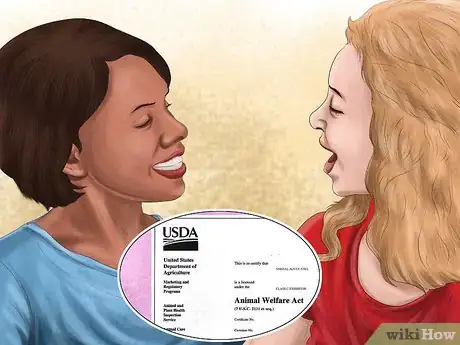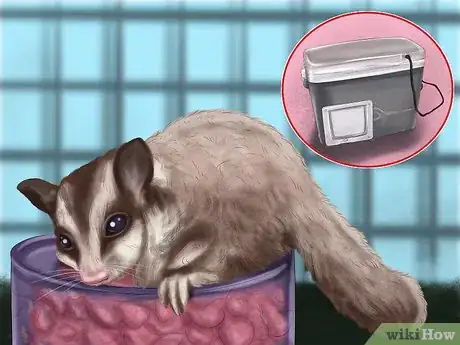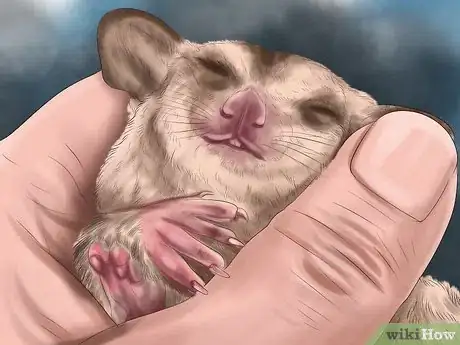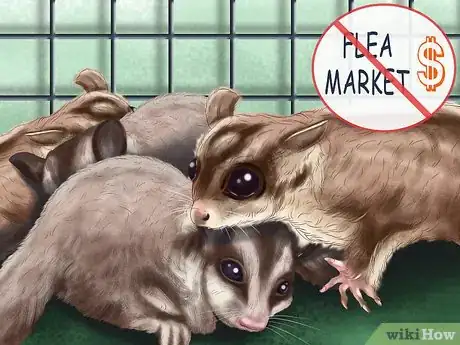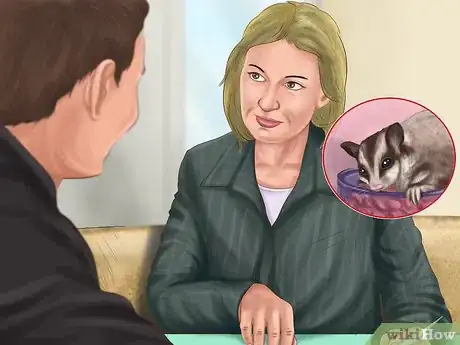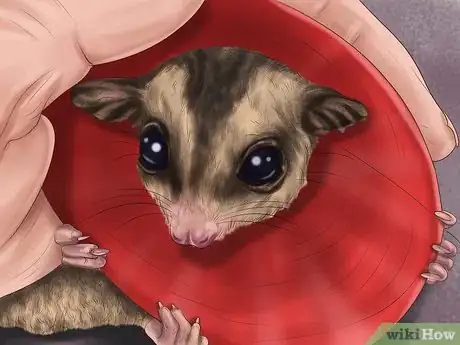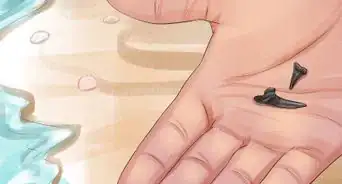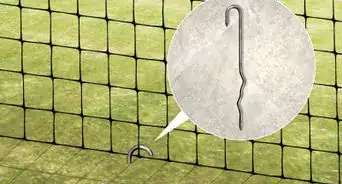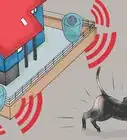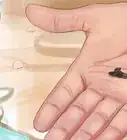This article was co-authored by wikiHow Staff. Our trained team of editors and researchers validate articles for accuracy and comprehensiveness. wikiHow's Content Management Team carefully monitors the work from our editorial staff to ensure that each article is backed by trusted research and meets our high quality standards.
wikiHow marks an article as reader-approved once it receives enough positive feedback. In this case, 92% of readers who voted found the article helpful, earning it our reader-approved status.
This article has been viewed 20,301 times.
Learn more...
Sugar gliders are small marsupials native to Australia and parts of Indonesia. They are sold in the United States commercially as pets, though they are illegal in some states. If you're considering purchasing a sugar glider, you will want to make sure your new pet is healthy, so it can live a long and happy life. There are a variety of steps you can take to assure you bring home a healthy sugar glider.
Steps
Evaluating the Supplier
-
1Find a breeder. If you want a sugar glider, your best option is to find a breeder. Breeders work specifically with sugar gliders and will have more knowledge about how to care for them, therefore increasing the chance of you obtaining a healthy pet.
- Finding a sugar glider breeder can be difficult. It's not as easy as finding a breeder for a particular kind of dog as there are few specific networks for breeding sugar gliders. However, browsing the internet for breeders in your area is a good start. As sugar glider breeders aren't very common, you may have to travel to work with a breeder.
- Use some discretion. If a breeder offers to simply ship you a sugar glider, for example, this is a bad sign. A quality breeder will want to have some contact with potential owners to assure that his gliders receive quality care. You may have to contact several potential breeders before you find a good fit.
-
2Ask the right questions. When you do make contact with a breeder, you should ask certain questions. A good breeder will be more than willing to address your concerns as his or her goal will be finding a loving, safe home for his gliders.
- Ask the breeder how long he's been in the business, if he has a USDA license, if he offers after care support, and whether his gliders come with a health guarantee. You should also ask if you can see the pedigree information for your glider to make sure he has a healthy family tree.
- Ask the breeder how he cares for his gliders. Sugar gliders that are not well cared for are more likely to have health problems. Ask what kind of diet he supplies, what care regimens he follows, and any problems he's had with buyers in the past.[1]
- A good breeder will not hesitate to answer these questions. He should be able to provide fully thought out answers that show he genuinely cares about the health and wellbeing of his animals.
Advertisement -
3Be wary of pet stores. A pet store is another option when buying a sugar glider. While it's better to go through a breeder, it's not always an option as you may not find a breeder in your area. If you have to go to a pet store, understand there are certain risks.
- Pet store workers may not have as extensive knowledge of sugar gliders. They may not provide the healthiest diet or environment, which can increase the risk of your glider having health problems. Pet stores may also buy gliders from mills where gliders are bred poorly, leading to an increased risk for genetic conditions.
- If you do go to a pet store, ask some of the same questions you might ask a breeder. A pet store owner or worker may have less extensive answers but should still be able to provide you some information. You should choose a pet store where your questions are addressed the most thoroughly. Pet stores vary in quality and choosing a more renown, responsible pet store can increase the likelihood of you bringing home a healthy sugar glider.
-
4Take in the environment. You should never have a sugar glider shipped unless it's the only option. It's always best to check out the environment beforehand. This will allow you to see if the glider is being housed in a safe space. A poor quality habitat can translate to health problems later on. Consider the following questions when evaluating a sugar glider's environment.
- Are the sugar gliders kept in clean environments? Are their cages or containers spacious so that they can move around freely?[2]
- Is the temperature being monitored by a thermostat to assure that's it's neither too warm or too cold? Do the animals have enough food or water? Are water and food bowls clean and easily accessible?[3]
- Are the sugar gliders provided with toys and other forms of entertainment? If a sugar glider gets bored, this could lead to behavioral problems later on.[4]
Observing the Sugar Glider
-
1Do a nose-to-tail check. A good pet store or breeder will allow you to handle your sugar glider before purchase. When doing so, do a nose-to-tail check to make sure your glider's in good health.
- The eyes, nose, and ears should be clean and clear. There should be no discharge or unusual colors, as this indicates illness.[5]
- Does the glider have all of its teeth? Is his mouth free of signs of infection?[6]
- Do the glider's legs appear strong and free of injury? A sugar glider should be able to grasp with all four paws. Is his tail a normal length? Make sure there is no discoloration of staining around the rectum. This can indicate the glider has diarrhea, which may be a sign of a health problem.[7]
-
2Ask questions about the sugar glider's background. Once you've examined your sugar glider, ask the owner questions about his background. You want to make sure he has no history of health problems or any other issues before making a purchase.
- Ask about how he's been socialized. You do not want to purchase a sugar glider who's not used to being handled. This can lead to behavioral issues. Also, a sugar glider who hasn't been held or touched may make potential health problems hard to notice.
- Ask if there's been any disease in his litter or with other sugar gliders in his cage. Even if the sugar glider you want is perfectly healthy, if he's been around sick animals he could develop an illness after you bring him home.[8]
- If you're going through a breeder, ask about your sugar glider's family history. Is he at increased risk for any inheritable disorders? If possible, you want to get a sugar glider who has a healthy family tree.
-
3Recognize signs of injury or illness. Sugar gliders may become injured from playing or fighting. They may also come down with illnesses, especially when they're young. If you want a healthy sugar glider, make sure he's illness and injury-free.
- Sugar gliders are fairly active. They should crawl and play in their cages. If a sugar glider appears inactive, he may be sick. Sugar gliders should have bright eyes, a moist nose, pink gums, and a smooth coat. If his gums look dull, his nose is runny, his eyes are cloudy, or his coat is thin and patchy, this is also a bad sign.
- Look for sores on your sugar glider. Patchy red skin and rashes may develop around sores, which can be difficult to treat. You do not want to take home an injured sugar glider.
- If the sugar glider has left any droppings, take a look at them. The appearance of his droppings can be an indication of health. Small, hard droppings may be a sign the animal is prone to digestive issues.
-
4Watch for dehydration. Some sugar gliders have health conditions that cause them to dehydrate easily. These sugar gliders can be hard to care for longterm. If you notice abnormal breathing, a lack of energy, and dryness around the nose or mouth the sugar glider may be dehydrated. In this case, you may want to pick a different glider.
Taking Other Precautions
-
1Stay away from flea markets and glider mills. Sugar gliders can be hard to find. If you can't find a breeder or pet store, you may be tempted to go through a mill or flea market. However, sugar gliders from such places are not bred responsibly. They are very prone to both health and behavioral problems. Avoid getting a sugar glider from a mill or flea market as he is less likely to be healthy.
-
2Ask questions about a sugar glider's personality. You should ask a breeder or pet store owner a little about a sugar glider's personality before making a purchase. Like people, sugar gliders vary in personality. Some are friendlier while others are more withdrawn. A certain personality type is not necessarily indicative of a sugar glider's health. However, if you wanted a more social or more playful pet this is something you should take into consideration.
-
3Prepare for setbacks, even when being cautious. Keep in mind there is no guarantee of perfect health, even when taking precautions. Sugar gliders, like any animal, can come down with a health issue at any point at life. Before deciding to purchase a pet, make sure you're prepared financially to deal with any health issues that might arise in the future.
Community Q&A
-
QuestionIf I can't find a breeder, should I just get one from the pet store?
 Community AnswerYes, that would be fine.
Community AnswerYes, that would be fine. -
QuestionIs there a specific type of sugar glider I can get?
 Community AnswerThere are multiple different color variations. They can be Albino, Platinum, Standard Grey, and Mosaic.
Community AnswerThere are multiple different color variations. They can be Albino, Platinum, Standard Grey, and Mosaic. -
QuestionWhy can't I ship a sugar glider?
 Community AnswerThey are live animals and they can only transported in a safe and careful way. They can become easily stressed and shipping them would be dangerous.
Community AnswerThey are live animals and they can only transported in a safe and careful way. They can become easily stressed and shipping them would be dangerous.
References
- ↑ http://www.peteducation.com/article.cfm?c=18+1798&aid=3296
- ↑ http://www.peteducation.com/article.cfm?c=18+1798&aid=3296
- ↑ http://www.peteducation.com/article.cfm?c=18+1798&aid=3296
- ↑ http://www.peteducation.com/article.cfm?c=18+1798&aid=3296
- ↑ http://www.peteducation.com/article.cfm?c=18+1798&aid=3296
- ↑ http://www.peteducation.com/article.cfm?c=18+1798&aid=3296
- ↑ http://www.peteducation.com/article.cfm?c=18+1798&aid=3296
- ↑ http://www.peteducation.com/article.cfm?c=18+1798&aid=3296
About This Article
To pick a healthy sugar glider, check it from nose to tail for signs of illness or injury. You should make sure its eyes, nose, and ears are clean and clear of any discharge. You should also check it has all its teeth and its mouth is clean. Once you’ve checked its face, make sure its legs are strong and it can grasp with all four paws. Additionally, check its skin for any red patches or rashes. If the sugar glider seems weak or lethargic, it may be ill or dehydrated, so you should pick another one. For more tips, including how to choose a good supplier when buying a sugar glider, read on!

